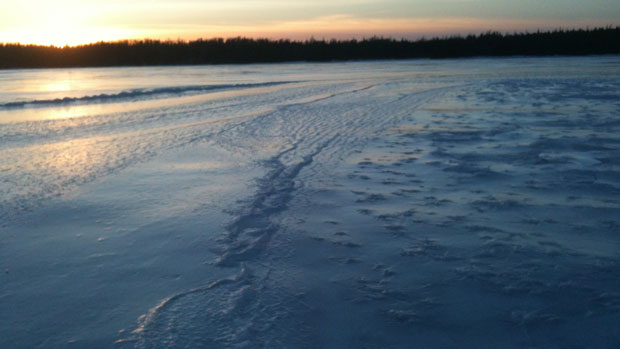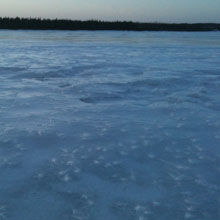Peter Butler said he was leaving his cabin on Powderhorn Lake on Sunday evening when he noticed a strange shape in the centre on the ice on the pond.
"It does appear that something punctured the ice and caused waves to form and travel over the ice," said Butler.
Butler said the hole was circular and about 30 metres across. He said water had seeped through the hole and frozen over, covering the initial hole with a thin layer of ice, water, and small fragments of ice. Butler also noticed ripples in the ice along the edge of the hole.
Similar to Dawe's Lake formation
Butler's sighting matched a description given Tuesday by amateur astronomer Jim Gillard of a similar formation on Dawe's Lake.
Gillard has speculated that a meteor or a piece of debris from an airplane or satellite caused the large hole on Dawe's Lake.
Like another cabin owner in that area of central Newfoundland, Butler said he heard a loud noise during the early hours of Thursday morning. At the time, he chalked it up to his dog knocking something over in his cabin and he went back to sleep.
Earlier that night, Butler thought he saw a flash of light coming from near Powderhorn Lake, but he assumed it was a light from a snowmobile.
Meteorite doubts
Meanwhile, Gary Dymond, another amateur astronomer and the Newfoundland and Labrador representative with the Meteorite Impact Advisory Committee, said he has doubts that the formations at Dawe's Lake were caused by a meteorite.
He has studied photographs of the Dawe's Lake site and talked to people who were there, and he said there have been no signs of a meteor impact - such as small, black fragments of rock. He also checked online sources for reports of space or aircraft debris falling from the sky and has come up with nothing.
Comment: The most comprehensive observation records are kept by amateur astronomers and these certainly do not catch everything. In addition, immediately locating meteorites from something that exploded high up in the atmosphere and sent at least two objects crashing through the ice 6 kms apart, is like trying to find a needle in a haystack. A team of underwater divers failed to locate anything under the ice around the impact site of a meteorite in a lake north of Chelyabinsk in Russia last month, although the largest meteorite from the event was eventually found next to the lake.
Dymond speculated that the strange hole could have been caused by a buildup of methane gas underneath the ice, which, if it exploded, could cause a loud noise and a large hole.
"It would be interesting to solve the mystery," said Dymond. "But I think it will stay as a mystery."
Looking for cause
Butler said he's still trying to come to terms with what he saw at Powderhorn Lake.
"You're thinking, 'Well, what was it? what caused it?'" wondered Butler. "If it was a meteor, well it's kind of scary too because I'm glad it was the pond [where it landed] and not one of the cabins."
"Regardless of what it is, I'd like to find out for peace of mind more than anything."





Comment: Sure, we'd all like peace of mind, but we're not going to get it if we exclude the flaming obvious from our investigations. Peter Butler's observation fits well with that of a woman who saw "two dark objects with smoky trails" fall out of a clear sky over Grand Falls-Windsor, Newfoundland at around 7:40 on Sunday evening. It seems that one of these space rocks hit Dawe's Lake, while the other one hit Powderhorn Lake. Between the flash of light, the loud boom, eyewitness sightings and identical descriptions of the 'ice crater' formations, it appears that at least two meteorites survived the fragmentation that followed an overhead explosion somewhere above Newfoundland on March 10th, 2013.
See also:
Large hole in Dawe's Lake, Newfoundland discovered following 'sonic boom'
Update! Witness saw two objects 'with smoke coming from them' fall out of sky near ice crater impact in Newfoundland - man-made 'space junk' ruled out